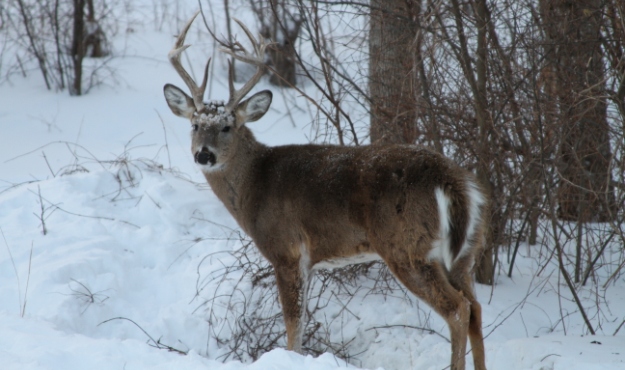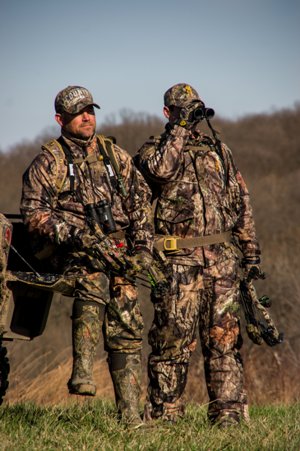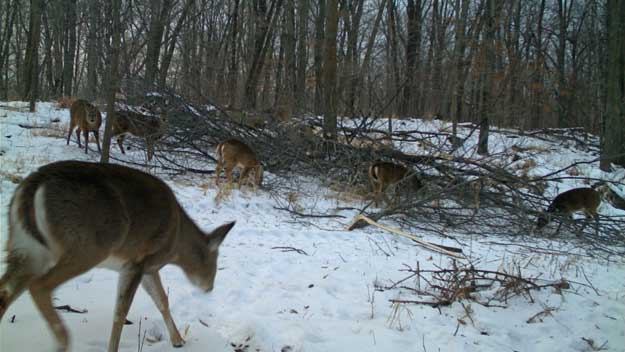
Editor’s Note: Brent Lafreniere lives in Williamstown, Vermont, and has been a Vermont resident his entire life. He’s been a Mossy Oak Pro Staffer for 6 years, has hunted deer for 25 years and hunts primarily public lands. “I’m a real fan of Mossy Oak Bottomland, but in the newer patterns I like Mossy Oak Break-up Infinity because I can use it not only for deer season but also for turkey season.” Because of winter deer kill and loss of habitat, the area where Lafreniere hunts is a really-difficult place to see or take deer. However, while hunting for 21 seasons in Vermont, Lafreniere has taken 19 deer. Because he’s such an avid hunter, he also travels to other states where deer season is open when Vermont’s season is closed, and where he can see and take more deer.
I first started traveling to other states to hunt when I was in high school. My dad used to go to Pennsylvania with some friends of his to hunt Pennsylvania’s early bow season. A few years after he started going to Pennsylvania, he’d get me out of school on Thursday, we’d drive to Pennsylvania and bow hunt the rest of Thursday, Friday and Saturday. At that time, Pennsylvania’s early bow season would start when Vermont’s season was closed. We’d usually go when the rut was still in progress in Pennsylvania and hunt a few days with muzzleloaders. We liked to hunt the states that might have deer that weighed 200 pounds or more. Hunting big blocks of woods in these other states was a different type of hunting than the little woodlots we hunted in Vermont.
I prefer to stalk hunt when I go to another state because I’m always wondering what’s over the next hill. If I find a spot where I know the deer are feeding or bedding, or where several fresh deer trails cross, I’ll put up a tree stand and hunt from that stand. I have a lot more patience to stay on a stand when the signs indicate I have a really good chance of seeing a deer. My family enjoys eating venison, and venison is a staple at our house. I think hunting’s in my genes. My great grandfather, my grandfather, my dad and I all have loved to hunt. One day I hope to pass on our family’s hunting tradition.
 Another reason I travel to hunt is Vermont often has hard winters with deep snow and below-freezing temperatures, which cause winter kill for both deer and turkey. Some of the states I go to don’t have those severe winters like Vermont has, and I have a better chance of seeing and taking both deer and turkey in these other states. My out-of-state hunts are far more than just deer hunts because I’ll go with several friends. We’ll start planning our hunts usually right after deer season ends for the upcoming deer season. We’ll be checking websites and searching for states with big deer and numbers of deer. Then we look for the counties that tend to produce the most deer and the biggest deer, and finally we try to find public lands that we can hunt in those counties. Next we get maps of the land we plan to hunt, and a Google Earth topo map. We overlay that map with a Google Earth aerial photo. Next we study the road system and pinpoint places that are 1/2- to 1-mile away from major access roads that have steep terrain, thick cover or some other type of terrain barrier that will cause most other hunters not to hunt there. Most public-land hunters don’t want to get more than a 100 yards from the road because they’re concerned about getting lost or worried that if they take big deer, they’ll have to drag them a long way.
Another reason I travel to hunt is Vermont often has hard winters with deep snow and below-freezing temperatures, which cause winter kill for both deer and turkey. Some of the states I go to don’t have those severe winters like Vermont has, and I have a better chance of seeing and taking both deer and turkey in these other states. My out-of-state hunts are far more than just deer hunts because I’ll go with several friends. We’ll start planning our hunts usually right after deer season ends for the upcoming deer season. We’ll be checking websites and searching for states with big deer and numbers of deer. Then we look for the counties that tend to produce the most deer and the biggest deer, and finally we try to find public lands that we can hunt in those counties. Next we get maps of the land we plan to hunt, and a Google Earth topo map. We overlay that map with a Google Earth aerial photo. Next we study the road system and pinpoint places that are 1/2- to 1-mile away from major access roads that have steep terrain, thick cover or some other type of terrain barrier that will cause most other hunters not to hunt there. Most public-land hunters don’t want to get more than a 100 yards from the road because they’re concerned about getting lost or worried that if they take big deer, they’ll have to drag them a long way.
Once we reach the public land we’re hunting in another state, we all study our maps. Each one of us goes to a different spot that we’ve identified on our maps as locations other hunters won’t hunt. The first day we usually spend all day scouting. Then that night we get together and compare notes about what we’ve learned from our scouting trips. Every morning before we go out to hunt we show each other where we’ll be hunting on our maps. We carry cell phones with us, so that if one of us takes a deer, he can call one or two of the hunters close to him to help him drag the deer out. If we don’t have cell phone service, because we’ve marked the spots we plan to hunt, if a hunter doesn’t get back to camp in a reasonable amount of time, we know where to go look for him. By using this system, we can hunt further away from access roads, go deeper into the woods, have help to drag our deer out and in case of a problem, be found.
I like to hunt other states because I see different terrain, I generally spot more deer, and I think I have an opportunity to take more deer than I have in Vermont, especially in the years when we have a hard winter. But there’s another component that’s just as important as the hunting. Going to another state with my friends and family is a big adventure. Instead of having only one person trying to determine where the best places are to hunt, we’ll often have three or four people researching and scouting the same public-hunting areas. We’ll meet together for lunch when we go to these areas, discuss what we’ve seen and make plans for the afternoon hunt. Every night we’ll review our notes from that day’s hunt and make plans for hunting the next day. The fellowship, the scouting, the planning and the sharing of what we’ve seen and learned each day makes these hunts so much more than just a hunting trip. Almost always someone in our group will get a deer, and often two or three hunters out of four will tag a deer. I believe that the system we use of having several hunters all working together to find more-productive places to take deer on public lands is a much-more efficient way to scout and hunt public lands than hunting public lands without several buddies.
Day 2: Learning about Brent Lafreniere’s Biggest Vermont Buck
Tomorrow: Remembering Brent Lafreniere’s Vermont Moose with a Bow






























